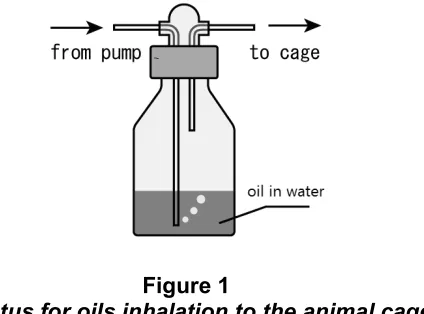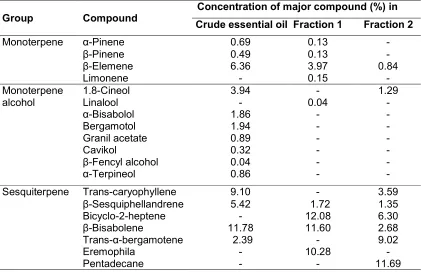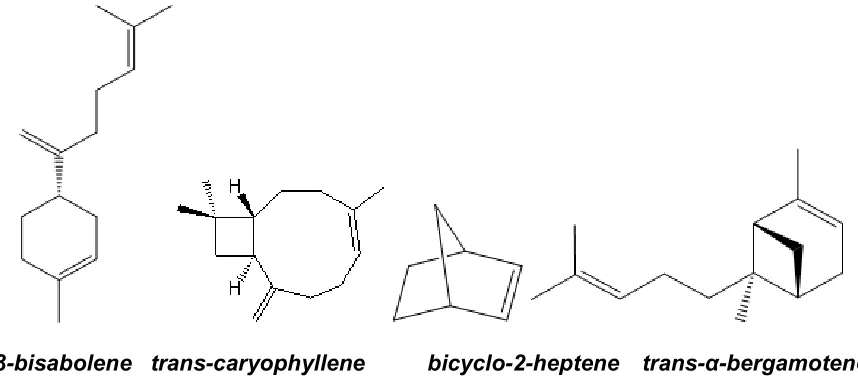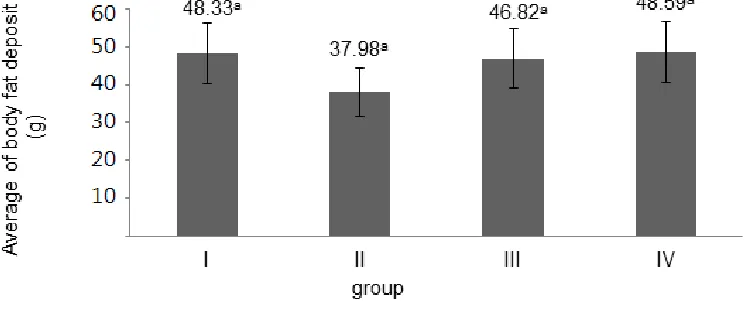Research Article Natural chemistry
International Journal of Pharma and Bio Sciences
ISSN
0975-6299
ESSENTIAL OIL OF RED GALANGAL (
ALPINIA GALANGA
(L) WILLD)
RHIZOMES AS SLIMMING AROMATHERAPY
RIZKI DAMAYANTI1, IRMANIDA BATUBARA1,2 AND IRMA HERAWATI SUPARTO*1,2,3
1
Department of Chemistry, Faculty of Mathematics and Natural Sciences, Bogor Agricultural University, IPB Campus, Darmaga, Bogor, 16680, Indonesia
2
Biopharmaca Research Center-Bogor Agricultural University, Bogor, 16128, Indonesia 3
Primate Research Center-Bogor Agricultural University, Bogor, 16151, Indonesia
ABSTRACT
Red galangal (Alpinia galanga (L) Willd) is an aromatic plant which has potential as aromatherapy. The aim of this research was to evaluate and identify the red galangal essential oil as slimming aromatherapy through in vivo observation in adult male Sprague Dawley rats. The oil was separated by distillation and fractionated by silica gel column chromatography resulting five fractions. Crude essential oil, fractions 1 and 2 were further analyzed by gas chromatography-mass spectrometry and performed in vivo assay. The major compounds in the crude oil were β-bisabolene (11.78%) and trans-caryophyllene (9.10%); in fraction 1 was bicyclo-2-heptene (12.08%); and pentadecane (11.09%) in fraction 2. After five weeks of inhalation with 0.1% concentration, body weight showed significant difference (P<0.05) and animals inhaling the crude oil had the lowest body weight compared to fraction 1 but not different compared to control and fraction 2 treated animals. In conclusion, red galangal’s essential oil compound β-bisabolene and trans-caryophyllene were suggested as the responsible compounds that has slimming aromatherapy effect.
KEY WORDS: aromatherapy, slimming, red galangal, essential oil
*Corresponding author
IRMA HERAWATI SUPARTO
Department of Chemistry, Faculty of Mathematics and Natural Sciences, Bogor Agricultural University, IPB Campus, Darmaga, Bogor, 16680, Indonesia Biopharmaca Research Center-Bogor Agricultural University, Bogor, 16128, Indonesia
INTRODUCTION
Obesity is a very serious problem which is a result of a long term imbalance between calories consumed and calories expended1-2. People who have excess weight tend to have higher total plasma cholesterol (TPC) and triglyceride (TG) in their blood and lower HDL (high density lipoprotein)3. These conditions lead to the risk of various diseases such as adults (approximately 127 million people) do not have ideal weight and their obesity caused more than 300,000 deaths every year1. Many
efforts have been done to lose weight such as consuming synthetic medicine as well as natural products which commonly taken orally. Currently, there are two types of medicine in the market. First, medicine that act centrally by suppressing appetite and increasing satiety. Second, medicine that works in the intestine by inhibiting the absorption of fat6. Generally, obese patient prefer to consume natural (traditional) therapy rather than the synthetic one. They believed it is safer and cheaper. Aromatherapy herbal plant based medicine is a new approached and recently more explored as slimming alternative medicine. The plant compound that has potential as the slimming aromatherapy is the essential oils7-8. Essential oils have been reported to stimulate the release of endorphins, relieving physical and emotional discomfort as well as promoting a feeling of joy and well-being9. One of the plants that contain these oils are red galangal rhizomes and the essential oil content between 0.3% - 0.5%10. Red galangal rhizome has been reported to have several medicinal properties such as anti-inflammatory, analgesic, anti-hyperglycemic, anti-allergy, antimicrobial, antifungal, anticancer, antibacterial and antioxidant10. Study of the active compound in red galangal as slimming aromatherapy has never been reported. Therefore, the aim of this study was to identify the active compound from the crude essential oil as well as the fractions of red galangal that has potential as slimming aromatherapy in adult male Sprague Dawley rat.
MATERIALS AND METHODS
Materials
Materials in this study were dried red galangal from Takengon-Aceh Province (Indonesia), distilled water, ethyl acetate, chloroform, methanol, n-hexane, silica gel, silica gel aluminum plate G60F254 from Merck,
propylthiouracil (PTU) and kits for TPC and TG (BIOLABO). The laboratory animals were adult male Sprague Dawley rat obtained from the Biopharmaca Research Center - Bogor Agricultural University. The diets were standard diet and high fat diet added egg yolk and coconut oil.
Instrumentation
The instruments used in this study were oven, distiller, chromatography vessel, capillary pipe,
Gas Chromatography-Mass Spectrometry
(GC-MS) (Shimadzu-Qp-505), as well as animal cages equipped with inhalator tube.
Procedure
0.1% given for 5 weeks. The inhalation of oils was performed like shown in Figure 1. The oil gas from the bottle was distributed to all cages
in the treatment process. The amount of diets given to the animals were recorded daily and body weight were recorded every week.
Figure 1
Apparatus for oils inhalation to the animal cages.
Fasting blood samples of 1 ml in
ethylenediaminetetraacetic acid (EDTA) were collected from the tail vein after animals sedated with ketamine HCl and xylazine intraperitoneally (80mg/kg-weight and 10mg/kg-weight, respectively) at pre-treatment and at the end of experiment taken intracardially. The blood was to analyzed TPC and TG. Animals were euthanized by exsanguination. After confirming death, body fat tissues from the abdominal cavity and perineal area was collected and measured for its total weight. All procedures performed on these animals have been approved by the animal ethic committee of Bogor Agricultural University (No. 04.2013 IPB). Data from all parameters (body weight, fat tissues weight, plasma lipid, and diet consumption) were analyzed using complete randomized group method and ANOVA (Analysis of Variance) with confidence level of 95% (α level=0.05). Data that was significantly different (p<0.05) further tested by Duncan’s post hoc test.
RESULTS AND DISCUSSION
Determination of Red Galangal and
Extraction of Its Essential oil
Plant determination of red galangal from Takengon was performed by the Herbarium Bogorienses Laboratory of Indonesia Institute of Sciences Cibinong Bogor, Indonesia. It was
confirmed that it belongs to the subfamily of Alpinioideae and species Alpinia galanga12.
The moisture and ash content were
determined 6.02% and 4.78%, respectively. Moisture content less than 10% has longer storage time and more resistance to microorganisme contamination. The maximum ash content requirement for medicinal plant in Indonesia was 5%13. Therefore, this red galangal can be further used as medicinal plant. Isolation of essential oil from 500 g dried red galangal rhizome results was 0.3% v/w of yellowish oil. This result was similar to Bermawie et al. which reported that essential oil content of red galangal from Banten, Yogyakarta and Central Java, Indonesia was between 0.3-0.5%10.
Table 1
Fractions of essential oil from red galangal rhizome
Fraction Total spot in TLC analysis Yield (%)
1 6 63.5
2 4 8.8
3 3 3.6
4 4 7.1
5 3 1.3
Composition of Crude Essential Oil, Fraction 1 and Fraction 2
Composition analysis of crude essential oil, fraction 1 and 2 using GC-MS showed different compound composition (Table 2). The dominant component in the crude essential
oils was β-bisabolene (11.78%) and
trans-caryophyllene (9.10%). Fraction 1 has 3
main major compounds such as
bicyclo-2-heptene (12.08%), β-bisabolene (11.61%) and eremophila (10.28%). On the other hand, main compound in fraction 2 was
pentadecane (11.09%) and trans-α-
bergamotene (9.02%). The structure of major compounds were shown in Figure 2.
Table 2
Concentration of major compounds of the crude essential oil, fraction 1 and fraction 2
Group Compound
Concentration of major compound (%) in
Crude essential oil Fraction 1 Fraction 2
Monoterpene α-Pinene 0.69 0.13 -
Sesquiterpene Trans-caryophyllene 9.10 - 3.59
β-bisabolene trans-caryophyllene bicyclo-2-heptene trans-α-bergamotene
Figure 2
Structure of β-bisabolene, trans-caryophyllene, bicyclo-2-heptene and trans-α-bergamotene
Aromatherapy In Vivo Study
Inhalation response to the tested animal was by observing the initial and final weight, fat deposits, and changes in lipid profile (TPC and TG). Total daily diet consumption in all four groups were not significantly different through all treatment period (P>0.05, data not shown). For their body weight, at pre-treatment there was no difference among all groups (P>0.05), whereas at the end of treatment there was significant difference (P<0.05). Post hoc Duncan analysis showed that animals treated with crude essential oil showed lower body weight compared to fraction 1 treated animals but not different compared to the other two groups (Table 3). Unexpected finding, there were an increase of body weight response shown in animals treated with fraction 2 which was similar to the effect of inhalation by
Zingiber zerumbet14. The highest percent
reduction of body weight was shown in animals that inhaled crude essential oil (13.67%). The body weight reduction mechanism with aromatherapy method was reported by stimulating through the olfactory system. The inhaled active compound affected the autonomic nervous system related to lipolysis mechanisms and heat production in adipose cells, as well as decreased in appetite that lead to weight reduction15. Shen et al.
stated that the aroma of grapefruit oil with a dominant content of limonene affect the autonomic nervous system. This increased of lipolysis through histaminergic and reduced in appetite leads to weight loss16. However, Shen
et al. also reported that lavender aroma and its active compound linalool influenced the autonomic nervous system, lipolysis through histaminergic response and increase of appetite17.
Table 3
Average body weight male rat at pretreatment and post treatment
Treatment groups Pretreatment body weight (g) (P>0.05) Post treatment body weight (g) (P<0.05)
(I) Control 282.3 ± 13.6a 251.8 ± 25.3ab
(II) Crude Essential Oil 283.2 ± 22.0a 244.8 ± 25.8a (III) Fraction 1 287.7 ± 14.8a 266.8 ± 16.3b
(IV) Fraction 2 289.0 ± 6.2a 258.9 ± 16.1ab
Number that following by the same superscripts were not significantly different (P>0.05) (Duncan’s multiple range test).
According to WHO, obesity is defined as an excess in accumulation of fat that can be harmful to health18. The total weight of body fat
Group II showed a trend of lower average body fat deposit compared to the other groups. This trend showed that the crude essential oil tend to respond in a reduction of fat deposit which
leads to weight reduction. The reason of this insignificant result can be due to the possibility of relatively short treatment time and the limited number of animals in each group.
Figure 3
Average of body fat deposit after treatment. Group (I) control, (II) red galangal crude essential oil, (III) fraction 1 and (IV) fraction 2
Average concentration of TG after treatment showed no significant difference (p>0.05) (Table 4). Farouk et al. 15 reported that male rat albino normal TPC concentration was around 115 mg/dl. Also reported the concentration of TPC in white rat (Rattus
norvegicus) was between 97.44-102.40
mg/dl19. Sukcow et al. and Fahri et al. reported that the concentration of TG in white rat was around 25-145 mg/dl19-20. These previous results illustrated that the concentration of TPC and TG in this study was in the normal range. .
Table 4
Total plasma cholesterol and triglycerides concentration after 5 weeks treatment
Treatment groups Total plasma cholesterol (mg/dl) (P>0.05) Triglycerides (mg/dl) (P>0.05)
(I) Control 107.3 ± 34.9a 47.69 ± 6.99a
(II) Crude Essential Oil 106.6 ± 45.7a 47.97 ± 10.30a (III) Fraction 1 79.9 ± 63.9a 37.83 ± 8.48a
(IV) Fraction 2 83.5 ± 10.7a 43.51 ± 13.09a
Number that following by the same superscripts was not significantly different (P>0.05) (Duncan’s multiple range test)
CONCLUSION
Fractionation of essential oils using polarity improvement methods result in five fractions with the selected fractions were fraction 1 and 2. GC-MS results showed that the dominant compounds in crude essential oil of red galangal were β-bisabolene (11.78%) and trans-caryophyllene (9.10%). Fraction 1 contains 4 main compounds which were bicyclo-2-heptene (12.08%), β-bisabolene
(11.61%), β-farnesena (10.28%) and
eremophila (10.28%), whereas the main
compound in fraction 2 were pentadecane (11.09%) and trans-α-bergamotene (9.02%). The result of 5 weeks of inhalation in the adult male rats showed that the crude essential oil with concentration of 0.1% has potential as slimming aromatherapy.
ACKNOWLEDGMENT
Directorate General of Higher Education, Ministry of Education and Culture Republic of
Indonesia No 084/SP2H/PL/Ditlitabmas/V/ 2013 and 9/IT3.11/LT/2014.
REFERENCES
1. Rahardjo S, Ngatijan, Pramono S. Influence of ethanol extract of jati belanda leaves (Guzuma Ulmifolia Lamk.) on lipase enzyme activity of Ratus norvegicus serum. Inovasi. 4 (17): 48-54, (2005)
2. Melnikova I, Wages D. Anti-obesity therapies. Nat Rev Drug Discov. 5: 369-370, (2006)
3. Dachriyanus, Katrin DO, Oktarina R, Ernas O, Suhatri, Mukhtar MH. Effect A-mangostin on total cholesterol, triglycerides, HDL cholesterol, LDL cholesterol of male white mice and determination of lethal doses 50 (LD50) (In Indonesian). J Sains Tek Far. 12 (2): 64-72, (2007)
4. Giannessi J, Alviar B, Agusta A. Variously substituted derivatives of guanidine, and their use as medicines with anti-diabetes and/or anti-obesity activity. U.S. Patent US 7368605, 2008
5. Lean M, Lara J, O’Hill J. ABC of obesity. Strategies for preventing obesity. Brit Med J. 333 (7575): 959-962, (2006)
6. Birari RB, Bhutani KK. Pancreatic lipase inhibitors from natural sources: unexplored potency. Drug Discov Today. 12 (19-20): 879-889, (2007)
7. Maniapoto K. “Aromatherapy: the language of scent is the sweetest melody” Accessed on April28th 2014. http: //www.nzase.org.nz/ events/aromatherapy. pdf.
8. Kumar A. Chemical composition of essential oil isolated from the rhizomes of Kaempferia galanga L. Int J Pharm Bio Sci. 5 (1): 225-231, (2014)
9. Aggarwal S, Agarwal S, Jalhan S. Essential oils as novel human skin penetration enhancer for transdermal drug delivery: A review. Int J Pharm Bio Sci. 4 (1): 857-868, (2013)
10. Bermawie N, Purwiyanti S, Melati , Meilawati. Ed. Morphological characters, yield and quality of the six galangas genotypes in three agroecological. Bul Littro. 23 (2):125-135 (2012).
11. Chudiwal AK, Jain DP, Somami RS. Alpinia
galanga Willd. -An overview on
phyto-pharmacological properties. Indian J Nat Prod Resour. 1(2):143-149, (2010) 12. Heyne K. Ed, Useful Plants Indonesia. (ID):
Department of Forestry: Jakarta, Indonesia, 575-577 (1987)
13. Dalimarta S., Ed. Atlas of Indonesian Medicinal Plants Vol 1 (In Indonesian). Trubus Agriwidya: Jakarta, Indonesia. 73-74, (2005)
14. Batubara I, Suparto I, Sadiah S, Matsuoka R, Mitsunaga T. Effect of Zingiber zerumbet
essential oil and zerumbone inhalation on body weight of Sprague Dawley rat. Pak Biol Sci. 16 (19): 1028-1033, (2013)
15. Farouk H, El-Sayeh BA, Mahmoud SS, Sharaf OA. Effect of olfactory stimulation with grapefruit oil and sibutramine in obese rats. J PAK MED STUD. 2 (1): 3-10, (2012) 16. Shen J, Niijima A, Tanida M, Horii Y, Maeda
K, Nagai K. Olfactory stimulation with scent of grapefruit oil effects autonomic nerves, lipolysis and appetite in rats. Neuroscience Letters. 380: 289-294, (2005a)
17. Shen J, Niijima A, Tanida M, Horii Y, Maeda K, Nagai K. Olfactory stimulation with scent of lavender oil effects automatic nerves, lipolysis and appetite in rat. Neuroscience Letters. 383: 188-193, (2005b)
18. [WHO] World Health Organization. “Obesity and Overweight” Accessed on April 28th 2014. http://www.who.int/topics/obesity/en/ 19. Harini M, Astirin OP. Blood choesterol levels
of hyperchoesterolemic rat (Rattus
norvegicus) after VCO treatment.
Bioscience. 1(2): 53-58, (2009).
20. Suckow MA, Weisbroth SH, Franklin CL. The Laboratory Rat. 2nd Edition. Elseiver Inc: Oxford, UK. 668-673, (2006)
21. Fahri C, Sutarno, Listyawati S. Glucose and total plasma cholesterol concentration in hyperglycemic white rat (Rattus norvegicus



